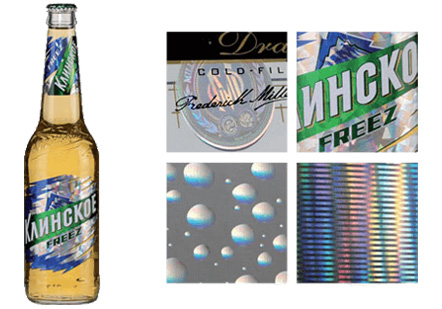Printing metallic effects can add a touch of elegance, sophistication, and visual appeal to various printed materials, including packaging, labels, invitations, and marketing collateral. Here are six popular methods for achieving metallic effects in printing:
Process Metallic Inks: These are specialized inks containing metallic pigments suspended in a transparent vehicle. Process metallic inks are applied using traditional printing processes such as offset lithography, flexography, or digital printing. They can create a wide range of metallic colors and effects, including gold, silver, bronze, and copper.
Spot Metallic Inks: Spot metallic inks are pre-mixed metallic colors applied to specific areas of the printed design. They provide more vibrant and consistent metallic effects compared to process metallic inks. Spot metallic inks are often used for highlighting logos, text, or graphic elements to create eye-catching accents.
Non-Wet Strength Holographic Metallized Paper
Foil stamping involves the application of a metallic foil film to the printed surface using heat and pressure. The metallic foil adheres to the substrate, creating a shiny, reflective effect. Foil stamping can be done in various metallic colors, including gold, silver, holographic, and matte finishes. It is commonly used for luxury packaging, invitations, book covers, and promotional materials.
Using metallic paper or substrates with a metallic finish can impart a metallic sheen to the printed design without the need for additional printing processes. Metallic papers are available in various colors and finishes, including silver, gold, and pearlescent. Printing on metallic substrates can enhance the visual impact of the printed piece, especially when combined with vibrant colors and intricate designs.

Wet Strength Holographic Metalized Paper
Embossing involves creating raised or recessed relief patterns on the printed surface using a die and pressure. Metallic embossing combines embossing with metallic foils or inks to create textured, dimensional effects with a metallic finish. This technique adds tactile and visual interest to printed materials, making them stand out and feel luxurious to the touch.
UV coating is a glossy, clear coating applied to the printed surface and cured using ultraviolet light. Metallic effects can be achieved by adding metallic pigments or flakes to the UV coating formulation. When applied over specific areas of the design, UV coatings with metallic effects create shiny, reflective highlights that enhance the overall appearance of the printed piece.
Digital printing technologies, such as toner-based and inkjet printers, now offer metallic printing capabilities. Specialized metallic toners or inks are used to achieve metallic effects directly in the digital printing process. Digital metallic printing provides flexibility, cost-effectiveness, and quick turnaround times for short to medium print runs, making it suitable for various applications, including personalized marketing materials and prototypes.
By leveraging these six methods, designers and printers can create stunning metallic effects that elevate the visual impact and perceived value of printed materials, helping brands stand out in a competitive marketplace.
Contact our team today if you have any questions at all. We are always really keen to help in any way that we can.
Copyright © HUBEI Y.F PACKAGING MATERIALS CO., LTD. All Rights Reserved | Sitemap
| Powered by 
Recommend Products: Pressure Sensitive Paper Beer Label Paper Water Resistant Paper for Labels What are the different types of holographic paper?